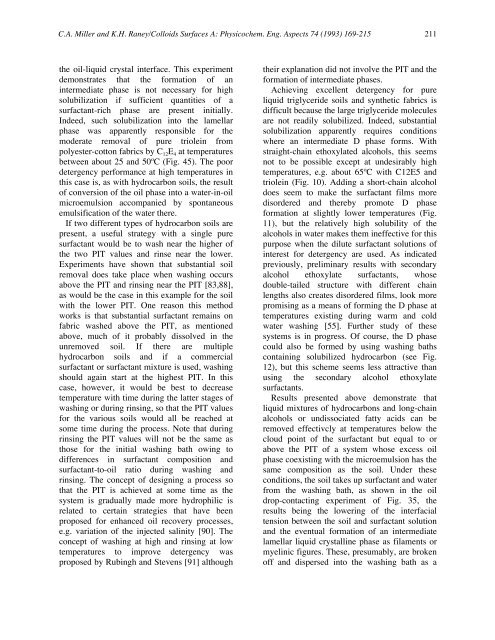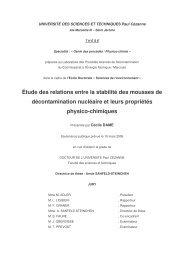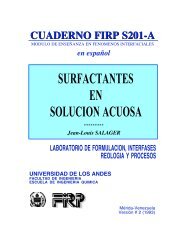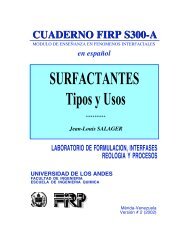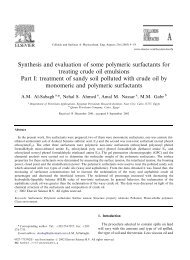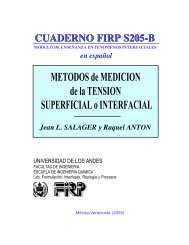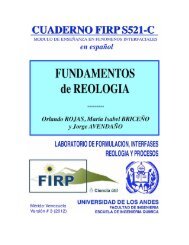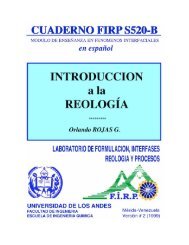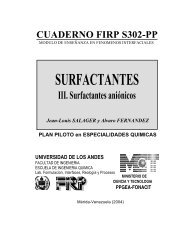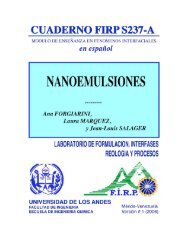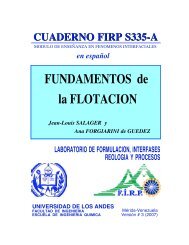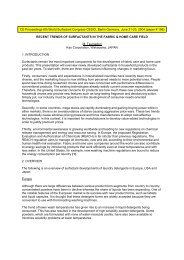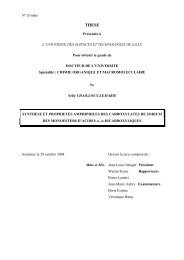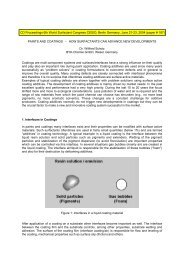Solubilization-emulsification mechanisms of detergency
Solubilization-emulsification mechanisms of detergency
Solubilization-emulsification mechanisms of detergency
Create successful ePaper yourself
Turn your PDF publications into a flip-book with our unique Google optimized e-Paper software.
C.A. Miller and K.H. Raney/Colloids Surfaces A: Physicochem. Eng. Aspects 74 (1993) 169-215 211<br />
the oil-liquid crystal interface. This experiment<br />
demonstrates that the formation <strong>of</strong> an<br />
intermediate phase is not necessary for high<br />
solubilization if sufficient quantities <strong>of</strong> a<br />
surfactant-rich phase are present initially.<br />
Indeed, such solubilization into the lamellar<br />
phase was apparently responsible for the<br />
moderate removal <strong>of</strong> pure triolein from<br />
polyester-cotton fabrics by C 12E 4 at temperatures<br />
between about 25 and 50ºC (Fig. 45). The poor<br />
<strong>detergency</strong> performance at high temperatures in<br />
this case is, as with hydrocarbon soils, the result<br />
<strong>of</strong> conversion <strong>of</strong> the oil phase into a water-in-oil<br />
microemulsion accompanied by spontaneous<br />
<strong>emulsification</strong> <strong>of</strong> the water there.<br />
If two different types <strong>of</strong> hydrocarbon soils are<br />
present, a useful strategy with a single pure<br />
surfactant would be to wash near the higher <strong>of</strong><br />
the two PIT values and rinse near the lower.<br />
Experiments have shown that substantial soil<br />
removal does take place when washing occurs<br />
above the PIT and rinsing near the PIT [83,88],<br />
as would be the case in this example for the soil<br />
with the lower PIT. One reason this method<br />
works is that substantial surfactant remains on<br />
fabric washed above the PIT, as mentioned<br />
above, much <strong>of</strong> it probably dissolved in the<br />
unremoved soil. If there are multiple<br />
hydrocarbon soils and if a commercial<br />
surfactant or surfactant mixture is used, washing<br />
should again start at the highest PIT. In this<br />
case, however, it would be best to decrease<br />
temperature with time during the latter stages <strong>of</strong><br />
washing or during rinsing, so that the PIT values<br />
for the various soils would all be reached at<br />
some time during the process. Note that during<br />
rinsing the PIT values will not be the same as<br />
those for the initial washing bath owing to<br />
differences in surfactant composition and<br />
surfactant-to-oil ratio during washing and<br />
rinsing. The concept <strong>of</strong> designing a process so<br />
that the PIT is achieved at some time as the<br />
system is gradually made more hydrophilic is<br />
related to certain strategies that have been<br />
proposed for enhanced oil recovery processes,<br />
e.g. variation <strong>of</strong> the injected salinity [90]. The<br />
concept <strong>of</strong> washing at high and rinsing at low<br />
temperatures to improve <strong>detergency</strong> was<br />
proposed by Rubingh and Stevens [91] although<br />
their explanation did not involve the PIT and the<br />
formation <strong>of</strong> intermediate phases.<br />
Achieving excellent <strong>detergency</strong> for pure<br />
liquid triglyceride soils and synthetic fabrics is<br />
difficult because the large triglyceride molecules<br />
are not readily solubilized. Indeed, substantial<br />
solubilization apparently requires conditions<br />
where an intermediate D phase forms. With<br />
straight-chain ethoxylated alcohols, this seems<br />
not to be possible except at undesirably high<br />
temperatures, e.g. about 65ºC with C12E5 and<br />
triolein (Fig. 10). Adding a short-chain alcohol<br />
does seem to make the surfactant films more<br />
disordered and thereby promote D phase<br />
formation at slightly lower temperatures (Fig.<br />
11), but the relatively high solubility <strong>of</strong> the<br />
alcohols in water makes them ineffective for this<br />
purpose when the dilute surfactant solutions <strong>of</strong><br />
interest for <strong>detergency</strong> are used. As indicated<br />
previously, preliminary results with secondary<br />
alcohol ethoxylate surfactants, whose<br />
double-tailed structure with different chain<br />
lengths also creates disordered films, look more<br />
promising as a means <strong>of</strong> forming the D phase at<br />
temperatures existing during warm and cold<br />
water washing [55]. Further study <strong>of</strong> these<br />
systems is in progress. Of course, the D phase<br />
could also be formed by using washing baths<br />
containing solubilized hydrocarbon (see Fig.<br />
12), but this scheme seems less attractive than<br />
using the secondary alcohol ethoxylate<br />
surfactants.<br />
Results presented above demonstrate that<br />
liquid mixtures <strong>of</strong> hydrocarbons and long-chain<br />
alcohols or undissociated fatty acids can be<br />
removed effectivcly at temperatures below the<br />
cloud point <strong>of</strong> the surfactant but equal to or<br />
above the PIT <strong>of</strong> a system whose excess oil<br />
phase coexisting with the microemulsion has the<br />
same composition as the soil. Under these<br />
conditions, the soil takes up surfactant and water<br />
from the washing bath, as shown in the oil<br />
drop-contacting experiment <strong>of</strong> Fig. 35, the<br />
results being the lowering <strong>of</strong> the interfacial<br />
tension between the soil and surfactant solution<br />
and the eventual formation <strong>of</strong> an intermediate<br />
lamellar liquid crystalline phase as filaments or<br />
myelinic figures. These, presumably, are broken<br />
<strong>of</strong>f and dispersed into the washing bath as a


